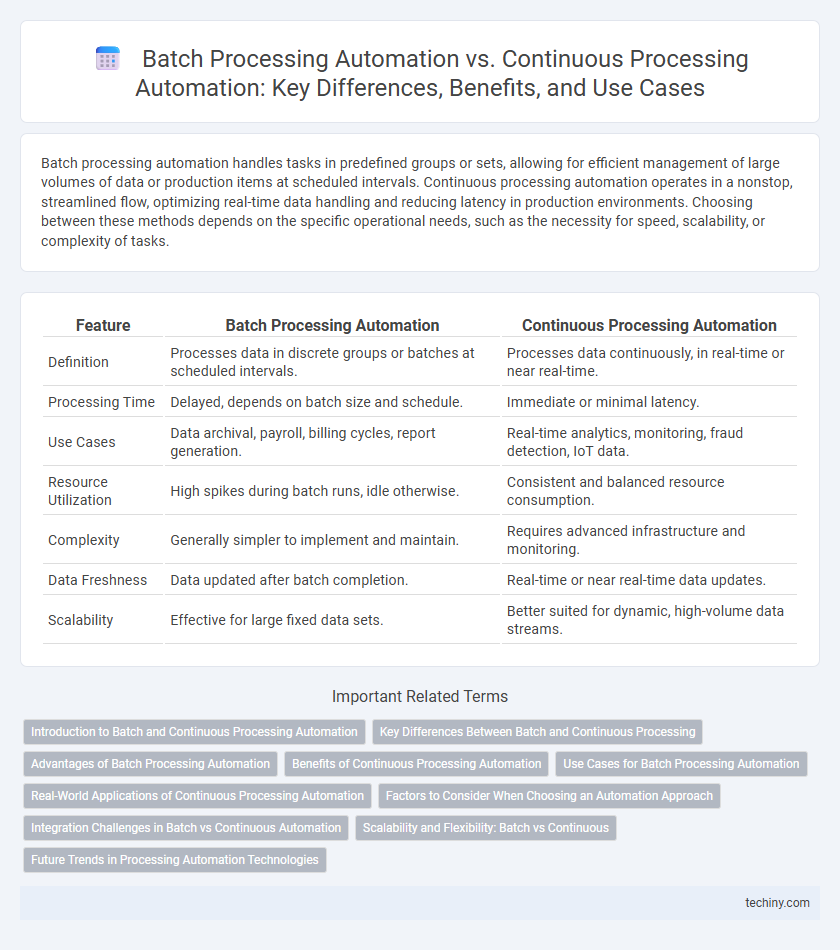Batch processing automation handles tasks in predefined groups or sets, allowing for efficient management of large volumes of data or production items at scheduled intervals. Continuous processing automation operates in a nonstop, streamlined flow, optimizing real-time data handling and reducing latency in production environments. Choosing between these methods depends on the specific operational needs, such as the necessity for speed, scalability, or complexity of tasks.
Table of Comparison
| Feature | Batch Processing Automation | Continuous Processing Automation |
|---|---|---|
| Definition | Processes data in discrete groups or batches at scheduled intervals. | Processes data continuously, in real-time or near real-time. |
| Processing Time | Delayed, depends on batch size and schedule. | Immediate or minimal latency. |
| Use Cases | Data archival, payroll, billing cycles, report generation. | Real-time analytics, monitoring, fraud detection, IoT data. |
| Resource Utilization | High spikes during batch runs, idle otherwise. | Consistent and balanced resource consumption. |
| Complexity | Generally simpler to implement and maintain. | Requires advanced infrastructure and monitoring. |
| Data Freshness | Data updated after batch completion. | Real-time or near real-time data updates. |
| Scalability | Effective for large fixed data sets. | Better suited for dynamic, high-volume data streams. |
Introduction to Batch and Continuous Processing Automation
Batch processing automation involves executing tasks in grouped sets, allowing for efficient handling of large volumes of data or transactions during scheduled intervals. Continuous processing automation enables real-time data flow and immediate task execution, supporting ongoing operations without interruption. Choosing between batch and continuous processing depends on factors like processing speed requirements, data volume, and operational complexity.
Key Differences Between Batch and Continuous Processing
Batch processing automation handles data or tasks in discrete groups, allowing for scheduled and controlled execution with clear start and end points. Continuous processing automation operates in real-time, delivering constant data flow and immediate output without interruptions. Key differences include timing, data handling methods, system complexity, and suitability for high-volume versus real-time applications.
Advantages of Batch Processing Automation
Batch Processing Automation offers enhanced control over large volumes of data by processing tasks in grouped sets, which minimizes resource contention and improves system stability. It enables easier scheduling and resource allocation, allowing businesses to optimize operational efficiency during off-peak hours. Additionally, batch automation reduces error rates through consistent, repeatable workflows that streamline complex data handling and integration tasks.
Benefits of Continuous Processing Automation
Continuous processing automation delivers enhanced operational efficiency by maintaining uninterrupted workflows, reducing downtime associated with batch transitions. It enables real-time data monitoring and immediate quality control, resulting in higher product consistency and minimized waste. This automation approach supports scalability and faster production rates, meeting dynamic market demands more effectively than batch processing systems.
Use Cases for Batch Processing Automation
Batch processing automation excels in use cases involving large volumes of data or transactions that can be processed collectively during off-peak hours, such as payroll processing, end-of-day financial reporting, and bulk data migration tasks. Industries like banking, telecommunications, and manufacturing leverage batch automation to efficiently handle repetitive, high-volume workflows that do not require immediate real-time output. This approach minimizes system downtime and optimizes resource allocation by grouping processes into scheduled batches, ensuring accuracy and consistency in data handling.
Real-World Applications of Continuous Processing Automation
Continuous processing automation significantly enhances real-world manufacturing operations by enabling real-time monitoring and rapid adjustments, which boost efficiency and reduce downtime. Industries such as pharmaceuticals, food and beverage, and chemical production benefit from continuous processing through improved product consistency and faster throughput. Integration with IoT devices and AI analytics further optimizes process control and predictive maintenance in continuous manufacturing systems.
Factors to Consider When Choosing an Automation Approach
Choosing between batch processing automation and continuous processing automation depends on factors such as data volume, processing time sensitivity, and system complexity. Batch processing suits large data sets that can be handled periodically without real-time constraints, while continuous processing is ideal for real-time analytics and immediate data updates. Resource availability, error tolerance, and scalability requirements also influence the selection of the appropriate automation approach.
Integration Challenges in Batch vs Continuous Automation
Batch processing automation often faces integration challenges due to the periodic nature of data handling, requiring complex scheduling and synchronization between systems to ensure data consistency. Continuous processing automation demands seamless real-time data flow integration, which can strain existing infrastructure and necessitate advanced middleware solutions for minimal latency. Both approaches must address compatibility issues with legacy systems, but continuous automation typically requires more sophisticated real-time monitoring and error-handling mechanisms.
Scalability and Flexibility: Batch vs Continuous
Batch processing automation enables scalability by handling large volumes of data or tasks in discrete chunks, making it suitable for scheduled, resource-intensive operations with predictable workloads. Continuous processing automation offers greater flexibility by processing data streams in real-time, allowing for dynamic adjustments and immediate reaction to changing inputs. Scalability in continuous automation relies on distributed architectures and real-time monitoring, supporting seamless expansion without interrupting workflows.
Future Trends in Processing Automation Technologies
Future trends in processing automation technologies emphasize the integration of AI-driven analytics and real-time data monitoring to optimize both batch processing automation and continuous processing automation. Advancements in machine learning algorithms are enabling adaptive control systems that enhance efficiency, reduce downtime, and predict maintenance needs. The convergence of IoT, edge computing, and cloud-based platforms supports scalable, flexible automation solutions that meet evolving industrial demands.
Batch Processing Automation vs Continuous Processing Automation Infographic

 techiny.com
techiny.com